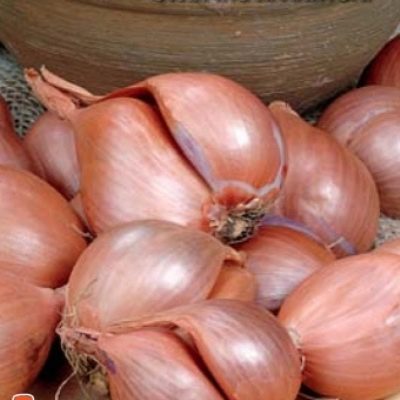
- Authors: Suzan V.G., Stepanov V.V.
- Year of approval: 2011
- Ripening terms: early
- Bulb weight, g: 26
- The form: elliptical
- Dry scales: dark red with brownish tint
- Coloring juicy scales: white with a purple tint
- Density: dense
- Taste: semi-sharp
- Appointment: universal
This shallots were approved for use in 2011. It is distinguished by its special frost resistance, resistance to infections. Monastyrsky onions can be cultivated both as an annual and as a two-year culture.
Description of the variety
This variety is distinguished by its rich vitamin composition and excellent taste. These shallots are considered an early variety. The variety boasts high immunity, good keeping quality. Monastyrsky onion is distinguished by good ripening. The plant is considered absolutely unpretentious. The culture is quite easy to grow.
Characteristics of the appearance of plants and bulbs
The bulbs are elliptical. The average weight of each fruit is 26 grams. The color of the dry scaly layer is dark red with a brown tint. The juicy scaly layer is white with an interesting purple tint.
Ripe fruits are quite dense, multi-nested (as a rule, there are 9 bulbs in one nest). The plant itself has a rich green color. The aerial part is tubular. A small waxy coating can be seen on its surface.
Purpose and taste
Monastyrsky onion has a wonderful semi-sharp taste. Its purpose is universal. This vegetable is perfect for eating raw. It is also often used for marinade, in the preparation of salads and other dishes.
Maturation
This variety is considered early. From the appearance of the first shoots to the harvest, it takes an average of 65-80 days.
Yield
This species has an average yield. From one square. m of plantings, on average, 0.8 kg of fruits are collected.
Growing regions
This shallots are grown in the following regions: North, North-West, Volgo-Vyatka, TsChO, Middle Volga, East and West Siberian, Central, Ural, Nizhnevolzhsky, Far East.
Growing and care
This variety is recommended to be grown as a biennial crop from seedlings. At the same time, sowing for seedlings is performed in March. Seedlings are planted in open ground in early May. Sevka planting is carried out in late April and early May. For planting, it is worth choosing well-lit areas.
The seeding pattern for such a culture is 30x4 cm, the seeding pattern is 20x2-3 cm. The sowing depth should not exceed 1 cm. The plant will need regular watering. In this case, a month before harvesting, watering must be stopped.
Shallots especially need feeding. Nutrient fertilizers should be applied twice over the entire period. Superphosphate and urea are the best options. Like other species, this variety also requires regular loosening and weeding.
To get the largest fruits possible, thinning is performed. The best time to do this is at the end of June. In this case, part of the bulbs is removed from each nest.

Since the onion is an unpretentious and cold-resistant plant, it can be planted both in spring and autumn. It is necessary to properly prepare the planting material, competently prepare the garden bed and determine the timing of planting.


The bow is not as unpretentious as it seems. For good growth, you need fertile soil, quality care and nutritious fertilizers. Without top dressing, the bulbs will grow small, and the greens will not be lush. At different stages, it should be fed with different substances. The vegetable needs organic and mineral feeding. A good result for fertilizing onions is the use of folk remedies.
Disease and pest resistance
Such shallots are very resistant to infections and pests. But still, sometimes he is affected by peronosporosis. At the same time, a purple-gray bloom will begin to appear on the leaves. Also, vegetation can be sick with Alternaria, in which spots of a saturated purple color begin to form on the leaves.
Root rot can also occasionally appear on such a crop. In this case, the roots are greatly thinned, acquire a pink color. The ends of the leaf blades may turn yellow. Some leaves wither immediately. If the culture is still sick, then chemical preparations should be used immediately. The best options will be the compositions "Maxim", "Quadris", "Pentofag", "Verticillin", "Mikosan".
The onion nematode causes white curvatures to form at the base of the mother's bulb. Other specimens can be infected through the soil in the future. To protect the culture from onion nematode, the infected fruit is treated in hot water, it can also be soaked in a formalin solution (1%).
Shallots are sometimes affected by various harmful insects, including the onion fly. When such a pest appears, the leaves turn yellow and gradually begin to fade. The fruits themselves become too small, they begin to rot quickly. Prevention of the appearance of onion flies is the regular loosening of the earth. Also, next to the onion, you can plant repellent plants (wormwood, tansy).

Despite the fact that the onion is a very useful plant, capable of repelling and killing many microbes and bacteria, it itself is often damaged and suffers from various misfortunes. Diseases and pests of onions can significantly reduce the yield. It is necessary to correctly determine the presence of this or that disease and take appropriate measures in time.
Review overview
Gardeners have left a lot of positive feedback about this variety. Many noted that this species is relatively large in size. In addition, ripe bulbs have excellent taste characteristics.
According to gardeners, the variety allows you to get a large harvest. Some have commented that such a bow is completely unpretentious in care. Ripe fruits can be used for processing and for fresh consumption.


















































































